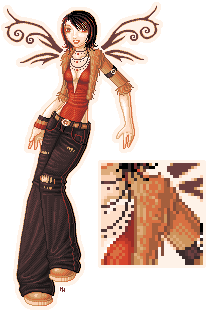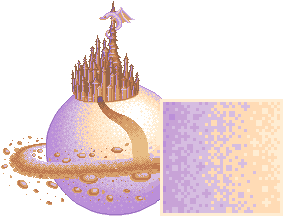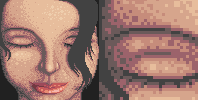| Dithering Lesson by blue |
|
What is dithering? Dithering is a technique of blending using noise, or a scattering of pixels. The most commonly used type of dithering is a simple 2x2 checkerboard pattern. It looks like this:  However, this is NOT the only form of dithering in existence. This is only the [dare I say] easiest and most widely known. Any form of blending that involves scattered or overlapping pixels can qualify as dithering. Generally, dithering is used when artists want to keep their color count down, to create middle shades between two colors without adding more colors to the palette. It also helps to blend the borders between colors, so that the piece loses that 'banded' look. It is also used to add texture to a piece. Different types of dithering can add different textures. I'll return to this a bit later. When should dithering be used [and avoided]? Many artists have the mistaken impression that dithering is the cure-all to their shading. This is most certainly NOT the case. It is a great technique for blending, and when used right it can smooth out a piece - however, as stated above it also adds texture to a piece. This works out well for certain things. For instance: denim has a rough sort of texture to it, thick and coarse, so dithering can frequently help bring this out in the fabric. Fur, also, has a distinctive sort of texture, and pattern dithering can bring out the strands and spice up the feel a bit. Canvas, corduroy, knitting, sequins, tulle, rocks, dirt, grass, tree bark, perhaps some skin - these all have distinctive, rough textures, and as a result, dithering can help enhance this. On the other hand, there are other textures that have extremely shiny, smooth textures to them. The clearest example of this would be fresh metal, like a silver cuff bracelet, or silk. Since these fabrics have such smooth surfaces, the light is reflected clearly off of them, and all of the shading is very bright and sharp. On these, all the lines should be straight and crisp, and dithering is vastly inappropriate. Silk, satin, hair, metal, plastic, glass, certain leather, vinyl -- all of these are smooth, and can be clouded or even ruined by dithering. And on top of this, the same dithering doesn't work for all textures. As I said above, fur isn't just enhanced by dithering -- it's enhanced by PATTERN dithering. A simple 2x2 checkerboard pattern doesn't simulate the way that fur falls and the lines that it follows. Fur generally is more like hair; there are strands and locks and clusters that fall every which way. So the dithering is made up of lines and curves and overlapping strands and looks a bit like this:  base Corduroy and knitted sweaters also follow their own sort of distinctive dithering techniques, since they're ribbed -- they're made up of raised lines and indents. So when dithering a sweater, for instance, the dithering should follow very straight, vertical or horizontal lines, a bit like this:  base Other textures that are more random and scattered, like dirt, or stone, or a sea of flowers -- these might need a custom designed dither. I suggest that, when deciding how to creature your textures, you actually look at photographs to get a feel for how things look and feel. Experiment with different types of overlap, don't be afraid to try anything that looks good! Here are some other various patterned dithering examples: dirt/stone:  base satiny:  for artistic reasons:  How do I dither? Basic Dithering step-by-step  This is the most standard kind of dithering; a simple 1px pattern. The left is called 25%, the middle 50%, and the third 75% for obvious reasons. ^.^  Pattern dithering step-by-step  I start with the basic 50% dither, and then put larger 'pattern' pieces on either side of the 'dividing line.' Then it really is a matter of trial and error, until it looks RIGHT. Fill in with smaller and smaller pieces, closer together near the dividing line and farther apart as you spread out. |
